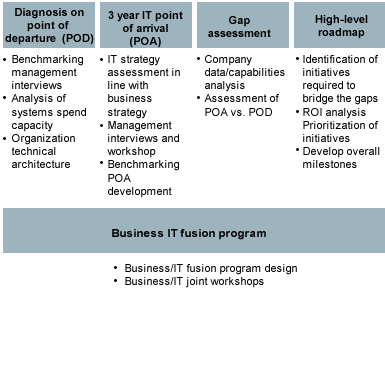The Situation
InsuranceCo*, a leading underwriter of life, auto and other insurance products, was undergoing a large-scale, strategic transformation with a strong focus on its technology infrastructure.
Although InsuranceCo spent less on technology than competitors, its ROI was weaker. In addition, its tech organization was weighted toward people with technical skills and lacked team members with business management skills. Meanwhile, senior management couldn't agree on the strategic direction for the function.
The industry was deregulating, and InsuranceCo needed faster and more flexible tech tools to cope with accelerated product life cycles, more integrated financial management, and increased demand for CRM capabilities.
InsuranceCo asked us to advise on the following issues:
- How does InsuranceCo's technology capability compare to industry benchmarks?
- Given its business strategy, what should InsuranceCo's tech strategy be in the future?
- How should that strategy be implemented?
- What governance and process should it follow to effectively and efficiently manage technology?
Our Approach
We created a 5-step approach to address these technology transformation challenges and issues.

Our Recommendations
- Ensure business/technology alignment by clarifying POD (Point of Departure) and POA (Point of Arrival) of technology capabilities
- Engage CIO in the business strategy development process to identify requirements related to business strategy & engage business management in planning, implementation, and assessment of tech projects
- Lead strategic technology decision-making and accountability to the business unit level
- Establish rigorous project management process
- Make decisions based on quantitative cost-benefit analysis
- Introduce new function of business analyst to bridge the communication gap between the business departments and technology department
- Pilot test with end-users in implementation
- Launch new function-based organization to increase efficiency and promote tech expertise through proper division of work
The Results
- Senior management reached agreement on IT strategic direction. A steering committee and business/IT fusion program have been set up to involve both business and IT personnel in sharing business needs and IT requirements
- A business analyst, acting as a new communication intermediary, is expected to significantly improve communication efficiency between business departments and IT, which was once highly cumbersome and ad-hoc.
- With rigorous prioritization of investment initiatives, the company can ensure control in IT spending.
- A new functional organization, combining similar functions once in different teams, will allow resource pooling and effective collaboration
- With re-defined KPI structure in close alignment with corporate strategy and IT vision, cooperation between IT organization and business departments are ensured. Further, transparent performance tracking is now in place.
- An initiative management manual, clearly manifesting documentation standards, cost/benefit methodology and work steps associated with each initiative, makes rigorous and systematic project management feasible
* We take our clients' confidentiality seriously. While we've changed their names, the results are real.
